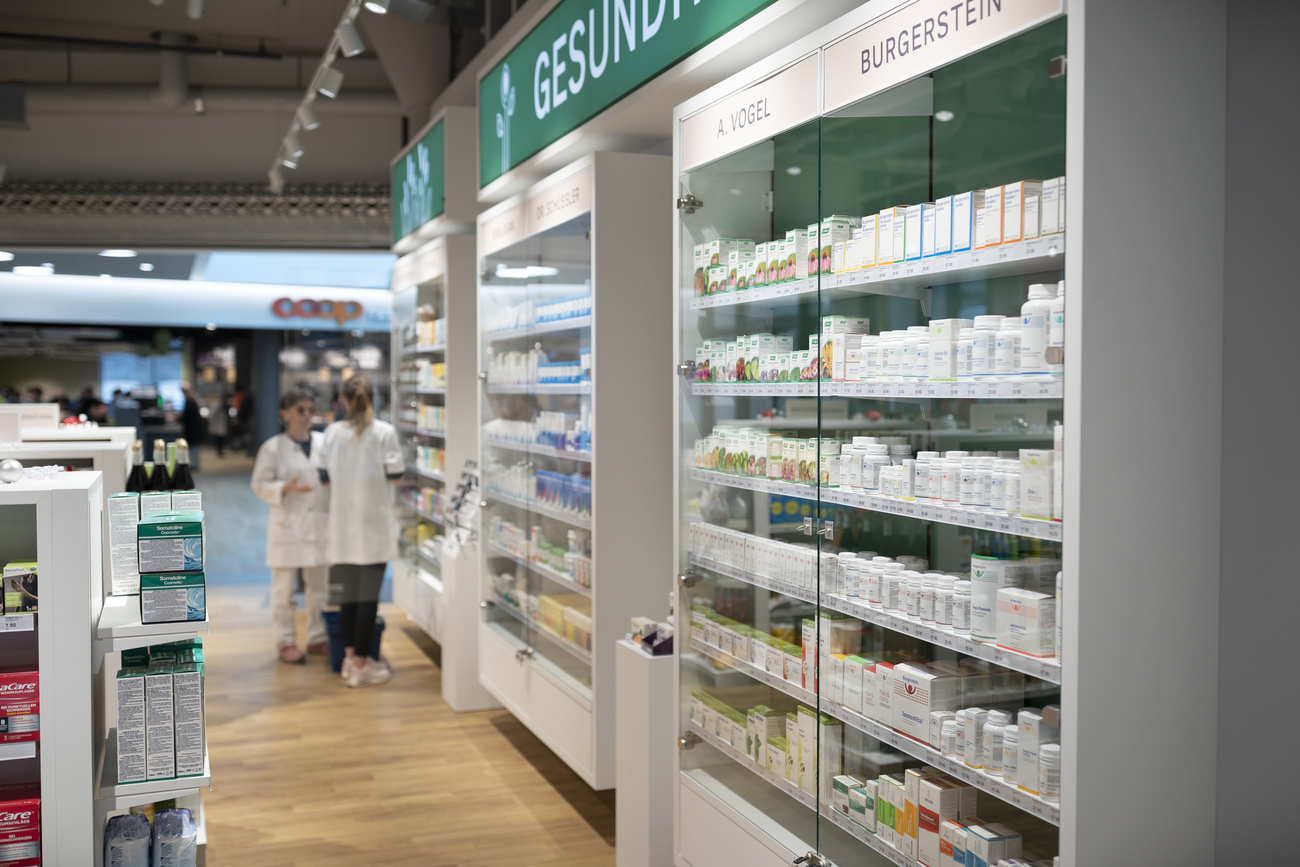Swiss pharmacies brace for shake-up as deregulation looms

Local drugstores in many parts of the world are disappearing, victims of rising costs and growing competition from online retailers. While Switzerland has so far escaped unscathed, pressure for change is mounting.
+Get the most important news from Switzerland in your inbox
People in Switzerland are used to going to their local pharmacy not just to pick up or buy medicine but for health advice for common ailments from skin rashes to digestive issues. In contrast to the United States, where pharmacies are embedded in retail shops selling candy and greetings cards, Swiss pharmacies are more like medical establishments.
Regardless of these differences, brick-and-mortar pharmacies have been essential parts of healthcare systems. But in many countries, they are in crisis. Costs have gone up for everything from energy to staffing, rising healthcare spending has patients, insurers, and health authorities looking for ways to save money, while online retailers are grabbing a larger share of the market.
“There is a lot of pressure on pharmacies themselves as a business but even more importantly as the first point of contact between patients and the healthcare system,” said Ilaria Passarani, secretary general of the Pharmaceutical Group of the European Union (PGEU), which represents community pharmacists. “Pharmacies, which are already short-staffed, are offering more services to patients to relieve pressure on doctors and nurses. But their services aren’t remunerated adequately.”
In response, community pharmacies – retail stores that dispense medicine outside hospitals – have been closing in droves in many parts of the world. In June, Walgreens, one of the largest drugstore chains in the US, announcedExternal link it would shutter 25% of its 8,600 outlets over the next three years.
More
In Germany, the number of pharmaciesExternal link has declined from around 21,500 in 2000 to just over 17,000 today. In Japan, some 22 dispensing pharmacies filedExternal link for bankruptcy in the first half of 2024, almost triple the number a year earlier and the most ever recorded for the period. In the United Kingdom, 700 out of some 14,000 pharmacies have shut in the last two yearsExternal link, according to the national pharmacy association.
In Switzerland, similar pressures are building, although so far the sector has managed to avoid mass closures. The number of pharmacies has remained stable at around 1,800 since 2008, but a major shake-up is looming as the authorities prepare to relax controls on online pharmacies that could open the floodgates to more competition.
“Online pharmacy” (also known as internet or mail-order pharmacy) is an umbrella term for retailers that dispense prescription medicines or sell non-prescription medicines directly to patients through the mail and provide information on their products and services via the internet. These include retail chains (such as Amazon) that operate online, online pharmacies that operate solely online, and brick-and-mortar pharmacies that have an online presence. Source: International Pharmaceutical FederationExternal link
Strong tradition
Pharmacies in Switzerland have been protected from major upheaval in large part because of how the industry is regulated and structured, and by the value society has traditionally placed on them and the services they offer.
Swiss pharmacies benefit from highly regulated drug prices. The Federal Office of Public Health sets a maximum price for medicine reimbursed by insurance providers. This price includes a fixed amount paid to pharmacies for logistics and services such as checking packaging labels.
While regulated prices can be found in many countries, it’s in stark contrast to the US, which has a mostly free market for drugs and little transparency over pricing. This has left US pharmacies at the mercy of insurance companies and intermediaries such as pharmacy benefit managers that pay “rock-bottom prices to the pharmacy – often below what the pharmacy purchased the product for from their distributor,” Michael Hogue, CEO, American Pharmacists Association, told SWI in an email.
Compared with other developed countries, Switzerland also has a relatively low ratio of pharmacies – roughly 21 per 100,000 people, lower than the EU average of 32. In some cantons, the ratio is even lower because doctors are also allowed to dispense medicine. The wave of expansion that took place in the UK and in the US in the 1990s, when Walgreens doubled the number of stores in just over a decade, didn’t happen in Switzerland.
That’s partly because there is a high bar for setting up a pharmacy – physical or online. To dispense prescription drugs and sell most non-prescription and over-the-counter (OTC) medicines, a pharmacy needs to be authorised by Swiss medicines agency Swissmedic, inspected by cantonal authorities, and be supervised by a licensed pharmacist. Product information also needs to be given in the three official languages: German, French and Italian.
Online sales face additional hurdles. In 2016, Switzerland introduced a law that banned the online sale of OTC medicines such as disinfectant creams, cough syrups, and ibuprofen without a prescription, making a consultation with a doctor mandatory. On top of this, electronic prescriptions are still not dispensed in Switzerland – something Germany introduced this year – adding logistical complexity and cost. Other countries such as Denmark fully transitioned to e-prescriptions years ago.
Many of these regulations are in place to protect patient safety, especially in the face of the growing problem of counterfeit drugs being sold online, but they have also stifled competition from online retailers. E-commerce sites that sell medicine such as Amazon or Alibaba are booming in many countries, for example China, India, the US and Brazil.
According to the Swiss pharmacists association, PharmaSuisse, mail-order pharmacies accounted for 7% of the CHF8 billion ($9 billion) compulsory insurance spent on medicine in 2023. Some data shows that in China, around 30% of OTC drugsExternal link are bought online. As of 2022, prescription drugsExternal link can also be sold online in China. In the US, some 37% of prescription drug revenueExternal link alone is done via mail-order pharmacies.
Cost pressures and shortages
The Swiss system has worked well for patients and community pharmacies up to now. But cracks are starting to show.
“Swiss pharmacies are under pressure – both financially and in terms of personnel,” said Gregory Nenniger, who heads digital communication for PharmaSuisse.
Pharmacists interviewed by SWI swissinfo.ch said higher energy costs and salaries were eating into their profits. It’s becoming increasingly difficult to find trained pharmacists who want to even work in a pharmacy let alone take over an existing one, according to one pharmacist in Bern.
To survive, many independent pharmacies, which account for two-thirds of all brick-and-mortar pharmacies, have joined networks like Dr. Gurtner Gruppe or TopPharm to save money through bulk purchasing, joint training and more advantageous credit terms. Pharmacies are also diversifying their services to include vaccinations, allergy checks, and nutritional advice, to bring in extra revenue and keep the profession attractive to pharmacists.

More
Why Switzerland is running out of pharmaceuticals
Drug shortages are exacerbating the situation, however. More than 1,000 medications, mostly low-cost generics, were unavailable in Switzerland in October 2024 compared with around 450 in May 2021, according to monitoring website drugshortages.ch.
“Supply bottlenecks caused by global crises pose major challenges for pharmacies: more work that pharmacists don’t get compensated for at all,” Nenniger said.
The Pharmaceutical Group of the European Union, which includes PharmaSuisse, estimates that it takes pharmacies on average ten hours more per week to look for alternatives to medicines they can’t get hold of – an additional cost that isn’t reimbursed through the current system. Some Swiss pharmacies resort to manufacturing small amounts themselves at an additional cost that then has to be negotiated with insurance companies.
Shortages also undermine the credibility of pharmacies. “Patients are unhappy and are losing trust in their pharmacist, because in the past they were able to get the medicines they were looking for every time they went to a pharmacy,” said Passarini. “Now they leave empty-handed.”
Pressure is also growing across the healthcare system to lower spending, and pharmacies are not immune. Switzerland already has the second most expensive healthcare system in the world, after the US. As the population ages and new, expensive treatments come onto the market, costs are skyrocketing for both patients and insurers. The KOF economic institute at federal technology institute ETH Zurich estimates that spending in 2026 will rise to CHF106 billion ($120 billion), 7% more than in 2024.
The federal parliamentExternal link and government are debating regulatory changes that would allow sales of OTC drugs online to lower drug prices and meet growing customer demands for convenience. There’s also strong backing for e-prescription and other efforts to digitalise the healthcare system.
A new kind of pharmacy
What this means for the future of community pharmacies in Switzerland is unclear. Large chains are swallowing up more brick-and-mortar pharmacies and laying the groundwork to capture a bigger share of the online drugs market.
GalenicaExternal link, a listed Swiss pharmacy chain, has acquired or opened between seven and 15 pharmacies in Switzerland per year since 2020. It now operates 374 outlets across the country – four times more than the next-largest pharmacy chain. It has also closed a small number of unprofitable stores.
Switzerland’s largest retailer, Migros, bought the Swiss operations of one of Europe’s largest online pharmacies Zur Rose (now called Doc Morris) last year. Shortly afterwards, Galenica struck a joint venture with Europe’s largest mail-order pharmacy Redcare (formerly shop Apotheke Europe).
Gian Marco Werro, a healthcare analyst at Zürcher Kantonalbank, predicts that the slow consolidation of physical pharmacies will continue, reducing the overall number of pharmacies. Changes to the OTC medicines regulations, which he expects in 2026-27, will also “increase pressure on brick-and-mortar pharmacies as it will become easier for consumers to shop around for the best prices,” he said.
So far, there’s little sign that the local pharmacy will be pushed aside by online retailers anytime soon. But brick-and-mortar pharmacies may look very different in the future. “Pharmacies are expected to extend their role as a low-threshold first point of contact in health-related matters,” Galenica spokesperson Andreas Petrosino told SWI swissinfo.ch.
The company is introducing offerings that connect online channels and local pharmacies. “As far as possible, we are meeting our customers wherever they are.”
Edited by Nerys Avery/Benjamin von Wyl/ts
Note: This article was updated on December 10 to include information about how drug pricing and reimbursement differs in the US.

In compliance with the JTI standards
More: SWI swissinfo.ch certified by the Journalism Trust Initiative









You can find an overview of ongoing debates with our journalists here . Please join us!
If you want to start a conversation about a topic raised in this article or want to report factual errors, email us at english@swissinfo.ch.